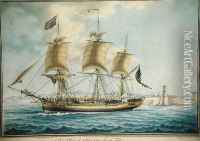Nicolas Cammillieri Paintings
Nicolas Cammillieri was a Maltese artist born in 1776 in Valletta, the capital city of Malta. He is primarily known for his maritime paintings and watercolors which captured the vibrancy of Mediterranean seafaring life in the 19th century. Cammillieri's works are particularly noted for their detailed representation of ships and harbor scenes, and they provide a valuable historical record of the vessels and maritime activities of his time.
Cammillieri's interest in maritime subjects was likely influenced by his surroundings and the importance of the port of Valletta as a hub of naval activity. During his lifetime, Malta was a strategic naval base, first for the Knights of St. John and later for the British Empire after Malta became a British protectorate in 1800. His works often depicted the ships and daily life around the Grand Harbour of Valletta, featuring a variety of vessels from naval frigates to merchant ships and smaller boats.
Despite the popularity of his maritime subjects, little is known about Cammillieri's training or early career. It is presumed that he was largely self-taught or may have apprenticed under a local artist. He started gaining recognition for his work in the early 19th century, and his paintings became sought after by both local patrons and foreign visitors to Malta. His clientele likely included naval officers and merchants who wanted keepsakes of their time on the island or depictions of their ships.
Cammillieri's artistic output was prolific, and he is known to have produced a large number of works throughout his career. His style is characterized by attention to detail, the use of light to create atmosphere, and the accurate portrayal of the sea and sky, which suggests a deep familiarity with maritime environments. Although he worked primarily in watercolors, he also executed works in oils and other mediums.
Nicolas Cammillieri continued to work and live in Malta throughout his life. He passed away in 1860, leaving behind a legacy of maritime art that continues to be appreciated for its historical value and artistic merit. Today, his works can be found in private collections and museums, and they remain an important part of Malta's cultural heritage, offering insight into the island's maritime past.
